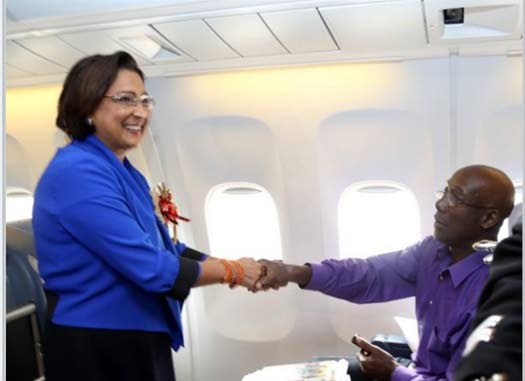Magic of air navigation


Part II
On Sunday, December 9, 2013 the prime minister, the leader of the opposition and other dignitaries departed TT on board a CAL Boeing 767-300ER aircraft to attended the memorial of the former president of South Africa, Nelson Mandela, in Johannesburg, South Africa.
The direct flight from Piarco International Airport to Johannesburg covered a distance of 6,944 nautical miles, with the aircraft flying seamlessly along airways through several flight information regions (FIR) at altitudes assigned by air traffic control (ATC).
The three-man cockpit crew operated this route for the first time with exactitude, thanks to crew competencies, the aircraft onboard navigation and communication equipment using the satellite-based global positioning system (GPS) and the uniform ICAO air navigation procedures.
Before the departure of the aircraft, a mandatory flight plan in an ICAO-approved format was filed with ATC and loaded into the ATC automated air traffic management system. The flight plan was also transmitted to all the FIR ATC units along the proposed route, using a dedicated air navigation digital network called the Aeronautical Fixed Telecommunications Network (AFTN).
A flight plan is essentially the plan of an aircraft route from the departure airport to the destination airport, specific to the aircraft and engines type. It contains the phases of flight, heading, speed, the waypoint co-ordinates, assigned altitudes, the distance between waypoints, flying time between waypoints, fuel burn between waypoints and, most importantly, the total trip fuel required.
The flight plan data was loaded into the aircraft flight management system (FMS), enabling the aircraft to fly at the assigned altitudes along the waypoints contained in the flight plan. The track of the aircraft and the waypoints along the route were displayed on a screen in the cockpit which the pilots monitored to ensure the aircraft was on course. During the flight, fuel endurance was monitored by comparing the actual fuel burn between waypoints with the "planned burn," to ensure fuel adequacy.
The aircraft was in constant contact with ATC units in the various FIRs via two-way VHF and HF radio providing position reports to ATC at least once every 30 minutes. The aircraft maintained two-way communication with CAL’s operations centre at Piarco via satellite radio.
After flying for just over 13 hours the aircraft landed safely at the OR Tambo International Airport, Johannesburg. All visual aids at airports including signage and markings comply with ICAO standards, enabling pilots to easily navigate to their assigned gate as directed by ATC ground control.
Before landing, the pilots reviewed the navigational charts for the airport for familiarity with the runway turnoffs, taxiways and gates.
Today, most charts are in electronic format and stored in a digital device, such as an iPad. This is called an electronic flight bag (EFB). EFBs store all the flight briefing information, navigational data, flight charts and other information, enabling pilots to efficiently retrieve information if needed.
The Boeing 767-300ER is a twin-engine aircraft and was required to comply with CAL’s approved extended twin-engine operational performance standards (ETOPS) limit of 120 minutes. This means that the flight path of the aircraft could not be more than 120 minutes away from a suitable airport at which the aircraft could make a landing in the event of an emergency such as engine failure.
A suitable airport is one with characteristics such as length and width that permit the aircraft to land with adequate stopping distance. Therefore, the aircraft was unable to fly the shortest distance between Piarco and Johannesburg.
However, thanks to favourable tail winds, the fuel on board met the legal requirements for the flight and a refuelling stop was unnecessary.
For the return trip on December 12, the normal tail winds became headwinds, increasing the flying time, and consequently the fuel burn. This initially required a refuelling stop in Recife, Brazil, creating a second flight sector. The refuelling stop had the potential for an overnight at Recife as the flight-crew limits could have been exceeded for a two-sector flight.
After takeoff from Johannesburg, the pilots were in constant communication with the Operations Centre at Piarco to get the latest enroute weather data, particularly headwinds. Calculations determined there was adequate fuel on board to fly the shortest distance between Johannesburg and Piarco.
However, a portion of the aircraft flight path would place the aircraft 133 minutes away from a suitable airport and 13 minutes in excess of the approved 120-minutes ETOPS. The crew sought and obtained a one-time regulatory approval to operate at 133 minutes ETOPS for approximately 1,000 nautical miles. This allowed the aircraft to fly directly to Piarco without a refuelling stop.
The aircraft landed safety at Piarco during the mid-afternoon. All the cockpit co-ordination and communication with ATC and CAL operations centre were transparent to the passengers on board.
This is the magic of air navigation.


Comments
"Magic of air navigation"